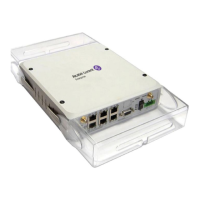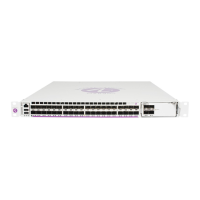VLL Services
7705 SAR OS Services Guide Page 165
Table 24 shows the VLAN ID translation operation (from ingress to egress) for the various
packet types. In Table 24, the following abbreviations are used to simplify the operations
shown in each cell, and the text in the cell represents the packet format.
• The packet payload at the service level is shown in parenthesis. It includes any SAP
headers.
• CV represents the Customer VLAN tag, where CV-i and CV-x represent the ingress
VLAN tag, and CV-e represents egress VLAN tag.
• PV represents the Provider VLAN tag, where PV can be either the customer-
configured VLAN tag (that is, CV-x) or a provider-configured VLAN tag (that is,
configured using the
spoke-sdp>vlan-vc-tag CLI command)
• PW represents the MPLS label, which consists of a PW label and a tunnel label.
• Dots in packet formats represent the places in an Ethernet frame where labels or tags
are added to a packet. Figure 27 shows two examples using the more familiar
representation of a packet format, where the packet starts on the right-hand side.
.
Table 23: Egress SAP Tagging Rules
Egress SAP Type
(1)
VC Type (Epipe)
Raw (Ethernet) Tagged (VLAN)
Null No operation Pop (VC tag)
Dot1q
Push (SAP tag)
(2)
Pop (VC tag)
Push (SAP tag)
(3)
Notes:
1. Ingress SAP type is configured at the port level.
2. If the SAP tag is 0, then no VLAN tag is pushed.
3. If the SAP tag is 0, then only the pop operation is performed.
Figure 27: Ethernet Frame Representations
Payload.CV-i
VLAN
tag
CV-iPayload
Payload.CV-i.PW
VLAN
tag
L1Payload CV-i L2
PW
label
Tunnel
label
MPLS tunnel
19786

